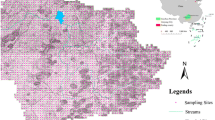Abstract
Soil organic carbon is of great importance to terrestrial ecosystems. Studies on the amount and spatial distribution of soil organic carbon stock in various types of soil can help to better understand the role of soil in the global carbon cycle and provide a scientific basis for the assessment of the magnitude of carbon stored in a given area. Here we present estimates of soil organic carbon stock in soils in the upper reaches of the Yangtze River based on soil types as defined by Chinese Soil Taxonomy and recently compiled into a digital soil database. The results showed that the total soil organic carbon stock of the upper Yangtze River to a depth of 100 cm was 1.452×1013 kg. The highest soil organic carbon stock was found in felty soils (2.419×1012 kg), followed by dark brown soils (1.269×1012 kg), and dark felty soils (1.139×1012 kg). Chernozems and irrigation silting soils showed the lowest soil organic carbon stock, mainly due to the small total area of such soils. The soil organic carbon density of these major soil types ranged from 5.6 to 26.1 kg m−2. The average soil organic carbon density of the upper reaches of the Yangtze River was 16.4 kg m−2, which was higher than that of the national average. Soil organic carbon density indicated a distinct decreasing trend from west to east, which corresponds to the pattern of increasing temperature from cold to subtropical.
Similar content being viewed by others
References
Batjes NH (1996) Total carbon and nitrogen in the soils of world. European Journal of Soil Science 47:151–163.
Bohn HL (1982) Estimate of organic carbon in world soils: II. Soil Science Society of America Journal 40:1118–1119.
Callesen I, Liski J, Raulund-rasmussen K, et al. (2003) Soil carbon stores in Nordic well drained forest soils relationships with climate and texture class. Global Change Biology 9:358–370.
Eswaran H, Berg E. van den, Reich P (1993) Organic carbon in soils of the world. Soil Science Society of American Journal 57:192–194.
Fang C, Moncrieff JB (2001) The dependence of soil CO2 efflux on temperature. Soil Biology & Biochemistry 33: 155–165.
Grace J (2004) Understanding and managing the global carbon cycle. Journal of Ecological 92:189–202.
Lal R (2004) Soil carbon sequestration impacts on global climate change and food security. Science 304:1623–1627.
Leifeld J, Bassin S, Fuhrer J (2005) Carbon stocks in Swiss agricultural soils predicted by land-use, soil characteristics, and altitude. Agric. Ecosystem Environment 105:255–266.
Li ZP, Han FX, Su Y, et al. (2007) Assessment of soil organic and carbonate carbon storage in China. Geoderma 138:119–126.
Michaelson, GJ, Ping CL, Kimble JM (1996) Carbon storage and distribution in tundra soils of Arctic Alaska, USA. Arctic and Alpine Research 28:414–424.
Morisada K, Ono K, Kanomata H (2004) Organic carbon stock in forest soils in Japan. Geoderma 119:21–32.
Ni JP, Yuan DX, Xie DT, et al. (2009) Estimation of soil organic carbon storage and the characteristic of carbon spatial distributions in karst area, Chongqing, China. Acta Ecological Sinica 29(11):6292–6301. (In Chinese)
Pan GX, Zhao QG (2005) Study on evolution of organic carbon stock in agricultural soils of China: facing the challenge of global change and food security. Advances in Earth Science 20(4):384–393. (In Chinese)
Parisa MK, Shamsollah A, Mohammad RM, et al. (2012) Soil organic carbon pools in particle-size fractions as affected by slope gradient and land use change in hilly regions, western Iran. Journal of Mountain Science 9: 87–95.
Parton WJ, Schimel DS, Cole CV, et al. (1987) Analysis of factors controlling soil organic matter levels in Great Plains grasslands. Soil Science Society of America Journal 51:227–260.
Ping CL, Michaelson GJ, Jorgenson T, et al. (2008) High stocks of soil organic carbon in North American Arctic region. Nature Geoscience 1(9): 615–619. DOI: 10.1038/ngeo284.
Schlesinger WH (1990) Evidence from chronosequence studies for a low carbon storage potential of soils. Nature 348:232–234.
Shi XZ, Yu DS, Warner ED, et al. (2004) Soil database of 1:1,000,000 digital soil survey and reference system of the Chinese genetic soil classification system. Soil Survey Horizons 45(4):129–136.
Tarnocai C, Canadell JG, Schuur EAG, et al. (2009) Soil organic carbon pools in the northern circumpolar permafrost region. Global Biogeochemical Cycles 23, GB2023, DOI:10.1029/2008GB003327.
Wang GX, Qian J, Cheng GD, et al. (2002) Soil organic carbon pool of grassland soils on the Qinghai-Tibetan Plateau and its global implication. The Science of the Total Environment 291:207–217.
Wang SQ, Huang M, Shao XM, et al. (2004). Vertical distribution of soil organic carbon in China. Environmental Management 33(1):200–209.
Wang S, Zhou C, Li K, et al. (2000) Study on spatial distribution character analysis of the soil organic carbon reservoir in China. Acta Geographic Sinica 55(5):533–544. (In Chinese)
Wang SQ, Zhou CH, Liu J, et al. (2002) Carbon storage in northeast China as estimated from vegetation and soil inventories. Environmental Pollution 116:157–165.
Wynn JG, Bird MI, Vallen L, et al. (2006) Continental-scale measurement of the soil organic carbon pool with climatic, edaphic, and biotic controls. Global Biogeochemistry Cycle 20(1), GB1007. DOI: 10.1029/2005GB002576.
Wu HB, Guo ZT, Peng C (2003) Distribution and storage of soil organic carbon in China Global Biogeochemical Cycles 9:305–315.
Yu DS, Shi XZ, Wang HJ, et al. (2007a) National scale analysis of soil organic carbon storage in China based on Chinese soil taxonomy. Pedosphere (1):13–20.
Yu DS, Shi XZ, Wang HJ, et al. (2007b) Regional patterns of soil organic carbon stocks in China. Journal of Environmental Management 85(3):680–689.
Zhang Y, Zhao YC, Shi XZ, et al. (2008) Variation of soil organic carbon estimates in mountain regions: A case study from Southwest China. Geoderma 146:449–456.
Zhao QG, Li Z, Xia YF (1997) Organic carbon storage in soils of southeast China. Nutrient Cycling in Agroecosystems 49:229–234.
Author information
Authors and Affiliations
Corresponding author
Rights and permissions
About this article
Cite this article
Wang, Xg., Zhu, B., Hua, Kk. et al. Assessment of soil organic carbon stock in the upper Yangtze River basin. J. Mt. Sci. 10, 866–872 (2013). https://doi.org/10.1007/s11629-012-2195-y
Received:
Accepted:
Published:
Issue Date:
DOI: https://doi.org/10.1007/s11629-012-2195-y




